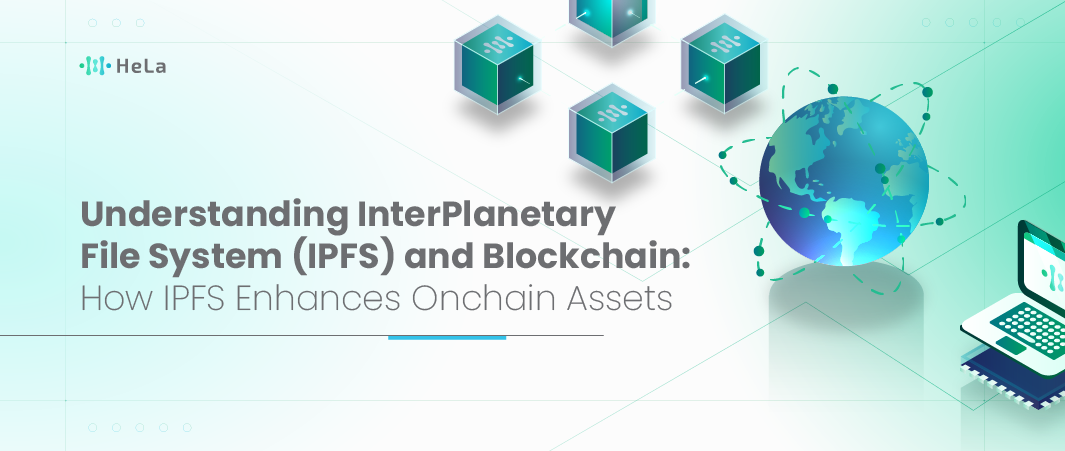Interplanetary file systems (IPFS) and blockchain are distributed technologies with a common goal of creating a secure and decentralized web. As decentralized technologies, they have numerous similar use cases. Thus, these combinations make a robust and resilient system in revolutionizing how we store, share, and manage data, offering unprecedented levels of security, and efficiency. But what is IPFS, how does it work, and how can it significantly enhance onchain assets in blockchain ecosystems?
What is the InterPlanetary File System (IPFS)?

IPFS is a decentralized, peer-to-peer file-sharing protocol designed to make the web faster, safer, and more open. Unlike traditional web protocols (such as HTTP) that rely on central servers, IPFS uses a distributed network of nodes to store and share files. This decentralization enhances the network’s resilience, making it less prone to failures and censorship.
What are the Key Features of IPFS?

- Decentralization: Traditional web systems rely on central servers to store and distribute content. This centralization makes them vulnerable to failures, attacks, and censorship. In contrast, IPFS operates on a decentralized network of nodes, each capable of storing and sharing files. This distributed nature enhances the network’s resilience, ensuring that data remains accessible even if some nodes go offline or are compromised.
- Content Addressing: In the traditional web, files are accessed by their location (URL). If the server hosting the file goes down or the URL changes, the file becomes inaccessible. However, IPFS uses content addressing, where files are identified by their content rather than their location. When a file is added to IPFS, it is assigned a unique hash based on its content. This ensures that when you request a file, you receive the exact version you need, free from tampering. Additionally, content addressing improves security and ensures the integrity and authenticity of the data.
- Versioning: IPFS supports versioning, allowing users to track file changes over time. This is particularly useful for collaborative projects with multiple file versions. Similar to version control systems like Git, IPFS can store different versions of a file, enabling users to access and revert to previous versions if necessary. This feature enhances collaboration and ensures that data remains consistent and up-to-date.
- Efficiency: IPFS improves efficiency by splitting files into smaller chunks and distributing them across the network. When a user requests a file, IPFS locates the chunks from the nearest nodes that have them, reassembles the file, and delivers it to the user. This method not only speeds up data retrieval but also reduces bandwidth usage. By utilizing nearby nodes, IPFS minimizes latency, providing faster and more efficient data access.
- Permanent Web: IPFS aims to create a more permanent and resilient internet. In the traditional web, content can be easily lost or removed. With IPFS, once a file is added, it remains accessible as long as at least one node continues to store it. This permanence ensures that valuable information and digital assets are preserved and available for future generations.
How does IPFS Work?

Content Addressing and Hashing
In IPFS, files are identified by their content rather than their location. This is achieved through cryptographic hashing. When a file is added to IPFS, it is split into smaller chunks, each of which is hashed. These hashes are used to create a unique identifier for the file, ensuring data integrity and authenticity. Using cryptographic hashes guarantees that the file cannot be tampered with without altering its hash, providing a secure and reliable data verification method.
File Distribution and Retrieval
Files in IPFS are divided into chunks and distributed across the network. When a user requests a file, IPFS locates the chunks from the nearest nodes that have them, reassembles the file, and delivers it to the user. This decentralized approach not only speeds up data retrieval but also ensures redundancy. Multiple nodes can store the same chunks, making the system more resilient to failures. Additionally, by retrieving files from the nearest nodes, IPFS reduces latency and improves download speeds, offering a more efficient and reliable way to access data.
Data Persistence and Pinning
Data in IPFS is persistent as long as nodes continue to store it. However, users can “pin” files to specific nodes to ensure critical data remains available. Pinning prevents the files from being garbage collected, guaranteeing their long-term storage. This feature is vital for preserving important digital assets and ensuring their availability over time. Users can maintain control over their data by pinning files and ensuring their persistence in the network.
IPFS and Onchain Assets: Synergy Between IPFS and Blockchain
IPFS and blockchain technologies complement each other perfectly. While IPFS excels at decentralized storage and data sharing, blockchain is unparalleled in securely recording and verifying transactions. By integrating IPFS with blockchain, we can leverage the strengths of both systems. IPFS can handle ample data storage and distribution, while blockchain can ensure data integrity and provide secure transaction recording.
Enhancing Onchain Assets with IPFS
- Data Storage: Onchain assets often require storing large files, such as digital media or documents. Storing these files directly on the blockchain is inefficient and costly. IPFS provides an ideal solution by storing the data off-chain while the blockchain stores metadata and hash references. This setup ensures data integrity without burdening the blockchain with large files. Users can access the data stored on IPFS using the hash references stored on the blockchain, combining the benefits of both technologies.
- Efficiency: Offloading large data storage to IPFS reduces the storage and computational load on the blockchain, improving its scalability and performance. This approach allows the blockchain to focus on transaction processing and verification while IPFS handles data storage and distribution. Separating these functions can create a more efficient and scalable system.
- Security and Integrity: Using IPFS’s content addressing ensures the integrity and authenticity of onchain assets. The cryptographic hashes stored on the blockchain can be used to verify that the data retrieved from IPFS has not been altered. This ensures that onchain assets remain secure and tamper-proof, providing users with confidence in the integrity of their data.
Practical Use Cases
- NFTs (Non-Fungible Tokens): NFTs represent unique digital assets. By storing the actual digital art or media files on IPFS and using blockchain to manage ownership and transactions, the system ensures the security and efficiency of NFT operations. The blockchain can store the metadata and hash references, while IPFS stores the large media files, providing a scalable and secure solution for managing digital art and collectables.
- Decentralized Applications (dApps): dApps can leverage IPFS for backend data storage while executing logic and transactions on the blockchain. This approach enhances the efficiency and functionality of dApps, allowing them to handle large datasets and complex processes without overloading the blockchain. Using IPFS for data storage, dApps can provide a seamless user experience and improve overall performance.
- Supply Chain Management: Using IPFS to store detailed product information and blockchain for tracking ownership and transfers ensures transparency and traceability in supply chains. IPFS can handle large volumes of data, such as product specifications, manufacturing details, and shipping records, while the blockchain records ownership changes and transaction history. This combination
Benefits of Using IPFS for Onchain Assets
- Cost Efficiency: By reducing the need for on-chain storage, IPFS lowers the costs associated with maintaining large datasets on the blockchain.
- Scalability: IPFS improves the scalability of blockchain systems by handling large data volumes more effectively.
- Data Integrity and Security: The cryptographic hashes used by IPFS ensure that data remains secure and tamper-proof.
- Interoperability: IPFS seamlessly integrates with various blockchain platforms, enhancing the flexibility and capabilities of decentralized applications.
Conclusion
The combination of IPFS and blockchain technologies offers a robust and efficient solution for managing onchain assets. Leveraging IPFS for decentralized storage and blockchain for secure transaction recording helps create a more scalable, safe, and efficient digital infrastructure.

Robert Mbogni
I am a technical writer and versatile technology professional with more than nine years of experience across engineering, software development, and IT operations. I was born in Cameroon and have built my career through a combination of academic achievement, hands-on industry work, and a deep commitment to continuous learning. I hold a postgraduate degree as a Mobile Application and Server Tester, along with a degree in Electrical Engineering, which has shaped the foundation of my analytical and problem-solving mindset.
Throughout my professional journey, I have contributed in a variety of roles, including Senior Process Executive, Technical Content Writer, Senior Software Engineer, IT Technical Support, Sales Engineer, and Data Engineer. This diverse background has allowed me to approach technology from multiple perspectives—technical, operational, and business-driven.
My skill set spans a wide range of programming languages, tools, and platforms, including Java, Python, C++, VBA, SQL query, and Power BI, as well as systems such as Windows, Linux, ERP, CRM, and analytics platforms like Google Analytics. I also have hands-on expertise with development and workflow tools including GitHub, Zoro Odoo, Vtiger, and Bitrix. This broad technical knowledge enables me to understand complex systems and communicate them clearly to both technical and non-technical audiences.
- Robert Mbogni#molongui-disabled-link
- Robert Mbogni#molongui-disabled-link
- Robert Mbogni#molongui-disabled-link
- Robert Mbogni#molongui-disabled-link

